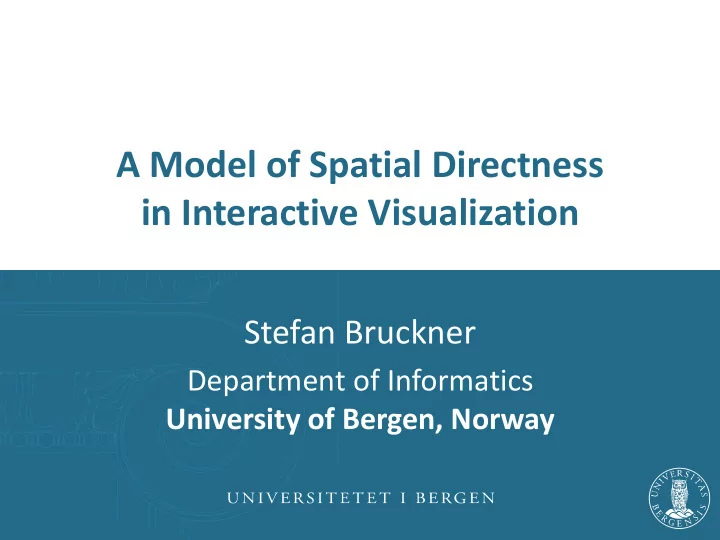

A Model of Spatial Directness in Interactive Visualization Stefan Bruckner Department of Informatics University of Bergen, Norway
Motivation (1) • What is “directness” in the context of interactive visualization? – Is it a useful notion for better understanding the interplay between visualization and interaction? – What are the (sub-)dimensions of directness? – Can we measure it? Can we predict it? 2
Motivation (2) 3
Modeling Directness (1) 4
Modeling Directness (2) • Two dimensions of directness – Visualization-interaction (vi) directness – Output-manipulation (om) directness • Higher directness means that respective mappings are “closer” to being their respective inverse 5
Example: Point Picking in VolVis • We encounter many values along a viewing ray • We can only display a single color per pixel • Higher vi-directness, if compositing function can be inverted 6
Types of Compositing (1) intensity profile along a viewing ray maximum intensity data value accumulation averaging first hit depth 7
Types of Compositing (2) intensity profile along a viewing ray maximum intensity data value accumulation averaging first hit depth 8
Types of Compositing (3) intensity profile along a viewing ray maximum intensity data value accumulation averaging first hit depth 9
Types of Compositing (4) intensity profile along a viewing ray maximum intensity data value accumulation averaging first hit depth 10
Types of Compositing (5) intensity profile along a viewing ray maximum intensity data value accumulation averaging first hit depth 11
Scenarios (1) 12
Scenarios (2) • 2D visualization of 2D data on a touchscreen (e.g., geographical maps) • Highest visibility point picking on a touchscreen in volume rendering • Non-spatial interaction (e.g., transfer function editing) on a touchscreen 13
Scenarios (3) • Surface-based visualization in a monitor & mouse setup • Direct volume rendering in a monitor & mouse setup • Proxy-based interaction in a monitor and mouse setup 14
Towards Measuring Directness importance/relevance of a data location x; models user tasks 15
Vis. Theory – Quo Vadis? (1) • Theories can be – Descriptive: describe/order/classify existing solutions, enabling a better understanding – Evaluative: enable the comparison between sets of alternatives – Generative: enable the synthetization of new (improved) solutions 16
Vis. Theory – Quo Vadis? (2) • Formulate objective measures that capture relevant properties of visualization techniques in a computable form • Associate these measures with task performance, make testable predictions, and actually test them • Perform in- silico “user studies” before evaluating visualization techniques • Synthesize new visualization methods 17
Recommend
More recommend